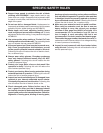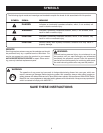
4 5
n Support large panels to minimize the risk of blade
pinching and KICKBACK. Large panels tend to sag
under their own weight. Supports must be placed under
the panel on both sides, near the line of cut and near the
edge of the panel.
n Do not use dull or damaged blade. Unsharpened or
improperly set blades produce narrow kerf which causes
excessive friction, blade binding and KICKBACK.
n Blade depth and bevel adjusting locking levers
must be tight and secure before making cut. If blade
adjustment shifts while cutting, it may cause binding and
KICKBACK.
n Use extra caution when making a “Pocket Cut” into
existing walls or other blind areas. The protruding blade
may cut objects that can cause KICKBACK.
n Know your power tool. Read operator’s manual care-
fully. Learn its applications and limitations, as well
as the specific potential hazards related to this tool.
Following this rule will reduce the risk of electric shock,
fire, or serious injury.
n Always wear safety glasses. Everyday eyeglasses
have only impact-resistant lenses; they are NOT
safety glasses. Following this rule will reduce the risk
of serious personal injury.
n Protect your lungs. Wear a face or dust mask if the
operation is dusty. Following this rule will reduce the
risk of serious personal injury.
n Protect your hearing. Wear hearing protection during
extended periods of operation. Following this rule will
reduce the risk of serious personal injury.
n Inspect tool cords periodically and, if damaged, have
repaired at your nearest authorized service center.
Constantly stay aware of cord location. Following this
rule will reduce the risk of electric shock or fire.
n Check damaged parts. Before further use of the
tool, a guard or other part that is damaged should
be carefully checked to determine that it will operate
properly and perform its intended function. Check for
alignment of moving parts, binding of moving parts,
SPECIFIC SAFETY RULES
breakage of parts, mounting, and any other conditions
that may affect its operation. A guard or other part that
is damaged should be properly repaired or replaced
by an authorized service center. Following this rule will
reduce the risk of shock, fire, or serious injury.
n Make sure your extension cord is in good condition.
When using an extension cord, be sure to use one
heavy enough to carry the current your product
will draw. A wire gage size (A.W.G.) of at least 12 is
recommended for an extension cord 50 feet or
less in length. A cord exceeding 100 feet is not
recommended. If in doubt, use the next heavier gage.
The smaller the gage number, the heavier the cord. An
undersized cord will cause a drop in line voltage resulting
in loss of power and overheating.
n Inspect for and remove all nails from lumber before
using this tool. Following this rule will reduce the risk of
serious personal injury.


















